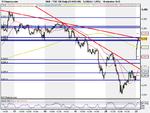At some point, probably before the end of 2010, the bubble will burst. The deflationary effect on the U.S. economy of $150 plus oil will overwhelm the modest forces of genuine economic expansion. The Treasury bond market will collapse, overwhelmed by the weight of deficit financing. Once again, the banking system will be in deep trouble. The industrial sector, beyond the largest and most liquid companies and the extractive industries, will in any case have remained in recession – it is notable that, in spite of the Fed's frenzy of activity, bank lending has fallen $600 billion in the last year. Unemployment, which will probably enter the second downturn at around current levels, will spike further upwards. The dollar will probably not collapse, but only because it will have been declining inexorably in the intervening year, to give a euro value of $2 and a yen value of 60 to 65 yen to the dollar.
In the next downturn, the Fed will not be able to cut interest rates, because inflation will be spiraling, as in 1980. Instead it will need to raise them while dealing with a profound crisis in the bond markets. Capital in the U.S. will become still more difficult to come by, and unemployment will approach 15%. The U.S.'s only saving graces will be that the inflation will have prevented much further decline in the nominal prices of houses, while the decline in the dollar will have finally swung the payments deficit towards balance. U.S. real wages will be forced downwards by high unemployment, while banks' relief on the home mortgage front will be balanced by a tsunami of collapsed credit card debt and other consumer debt.
2011 and 2012 will be very unpleasant years, as the Obama administration struggles to get closer to budget balance without pushing up taxes so far as to cause yet a third recession. Stock prices will be at or below their March 2009 lows, and will stay there even as earnings of export-oriented companies will be robust. (Conversely, retailers dealing in cheap imported goods, such as Wal-Mart, will be devastated.) Wages will be generally declining relative to prices, although may show some growth in nominal terms as inflation will be considerable. Foreign goods and services will be inordinately expensive in dollar terms.
The danger in those years will be that Ben Bernanke will attempt yet again to refloat the U.S. economy through inflation, buying government debt to fund the deficit and forcing short term rates well below the inflation rate. This danger is exacerbated by the Obama administration's insouciance about deficits. Ben Bernanke on his own (and his predecessor Alan Greenspan) bears a large share of responsibility for the 2008 crash, but the Bernanke/Obama combination is potentially even more dangerous. If expansionary monetary and fiscal policies are pursued regardless of market signals, the U.S. will head towards Weimar-style trillion-percent inflation. That would make the government's position easier as its mountain of Treasury debt became worthless, but devastate everybody else's savings and impoverish the American people as Weimar impoverished 1920s Germany.
As I said, a train wreck. Probability of arrival: close to 100%. Time of arrival: around the end of 2010, or possibly a bit earlier. And at this stage, there's very little anyone can do about it; the definitive rise of gold above $1,000 marked the point of no return.
The Bears Lair is a weekly column that is intended to appear each Monday, an appropriately gloomy day of the week. Its rationale is that, in the long '90s boom, the proportion of "sell" recommendations put out by Wall Street houses declined from 9 percent of all research reports to 1 percent and has only modestly rebounded since. Accordingly, investors have an excess of positive information and very little negative information. The column thus takes the ursine view of life and the market, in the hope that it may be usefully different from what investors see elsewhere.
Martin Hutchinson is the author of "Great Conservatives" (Academica Press, 2005). Details can be found on the Web site
www.greatconservatives.com


